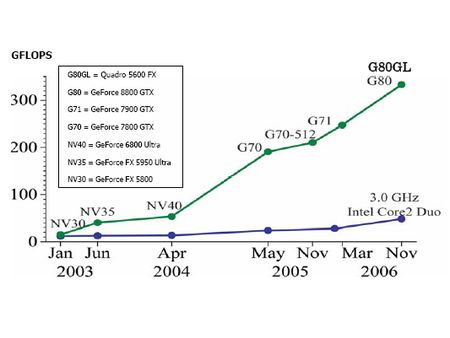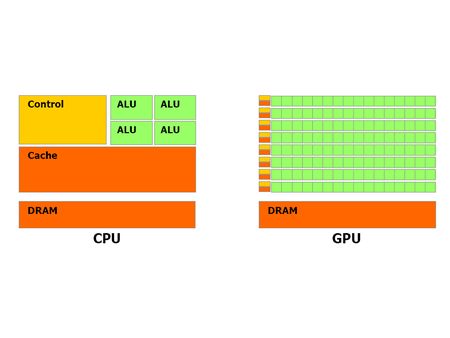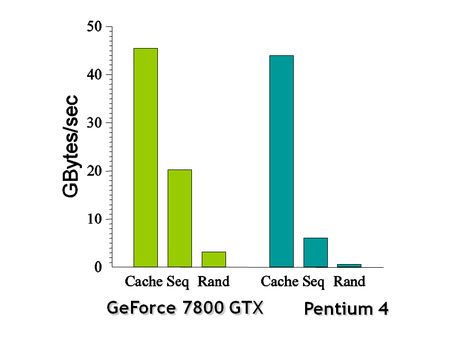Nvidia's CUDA: The End of the CPU?
Meanwhile...
Meanwhile, as CPU makers were tearing their hair out trying to find a solution to their problems, GPU makers were continuing to benefit more than ever from the advantages of Moore’s Law.
Why weren’t they handicapped in the same way as their confreres who design CPUs? The reason is very simple: CPUs are designed to get maximum performance from a stream of instructions, which operates on diverse data (such as integers and floating-point calculations) and performs random memory accesses, branching, etc. Up to that point, architects were working to extract more parallelism of instructions – that is, to launch as many instructions as possible in parallel. Accordingly, the Pentium introduced superscalar execution, making it possible to launch two instructions per cycle under certain conditions. The Pentium Pro ushered in out-of-order execution of instructions in order to make optimum use of calculating units. The problem is that there’s a limit to the parallelism that is possible to get out of a sequential stream of instructions, and consequently, blindly increasing the number of calculating units is useless, since they remain unused most of the time.
Conversely, the operation of a GPU is sublimely simple. The job consists of taking a group of polygons, on the one hand, and generating a group of pixels on the other. The polygons and pixels are independent of each other, and so can be processed by parallel units. That means that a GPU can afford to devote a large part of its die to calculating units which, unlike those of a CPU, will actually be used.
GPUs differ from CPUs in another way. Memory access in a GPU is extremely coherent – when a texel is read, a few cycles later the neighboring texel will be read, and when a pixel is written, a few cycles later a neighboring pixel will be written. By organizing memory intelligently, performance comes close to the theoretical bandwidth. That means that a GPU, unlike a CPU, doesn’t need an enormous cache, since its role is principally to accelerate texturing operations. A few kilobytes are all that’s needed to contain the few texels used in bilinear and trilinear filters.
Get Tom's Hardware's best news and in-depth reviews, straight to your inbox.
-
CUDA software enables GPUs to do tasks normally reserved for CPUs. We look at how it works and its real and potential performance advantages.Reply
Nvidia's CUDA: The End of the CPU? : Read more -
Well if the technology was used just to play games yes, it would be crap tech, spending billions just so we can play quake doesnt make much sense ;)Reply
-
dariushro The Best thing that could happen is for M$ to release an API similar to DirextX for developers. That way both ATI and NVidia can support the API.Reply -
dmuir And no mention of OpenCL? I guess there's not a lot of details about it yet, but I find it surprising that you look to M$ for a unified API (who have no plans to do so that we know of), when Apple has already announced that they'll be releasing one next year. (unless I've totally misunderstood things...)Reply -
neodude007 Im not gonna bother reading this article, I just thought the title was funny seeing as how Nvidia claims CUDA in NO way replaces the CPU and that is simply not their goal.Reply -
LazyGarfield I´d like it better if DirectX wouldnt be used.Reply
Anyways, NV wants to sell cuda, so why would they change to DX ,-) -
I think the best way to go for MS is announce to support OpenCL like Apple. That way it will make things a lot easier for the developers and it makes MS look good to support the oen standard.Reply
-
Shadow703793 Mr RobotoVery interesting. I'm anxiously awaiting the RapiHD video encoder. Everyone knows how long it takes to encode a standard definition video, let alone an HD or multiple HD videos. If a 10x speedup can materialize from the CUDA API, lets just say it's more than welcome.I understand from the launch if the GTX280 and GTX260 that Nvidia has a broader outlook for the use of these GPU's. However I don't buy it fully especially when they cost so much to manufacture and use so much power. The GTX http://en.wikipedia.org/wiki/Gore-Tex 280 has been reported as using upwards of 300w. That doesn't translate to that much money in electrical bills over a span of a year but never the less it's still moving backwards. Also don't expect the GTX series to come down in price anytime soon. The 8800GTX and it's 384 Bit bus is a prime example of how much these devices cost to make. Unless CUDA becomes standardized it's just another niche product fighting against other niche products from ATI and Intel.On the other hand though, I was reading on Anand Tech that Nvidia is sticking 4 of these cards (each with 4GB RAM) in a 1U formfactor using CUDA to create ultra cheap Super Computers. For the scientific community this may be just what they're looking for. Maybe I was misled into believing that these cards were for gaming and anything else would be an added benefit. With the price and power consumption this makes much more sense now. Agreed. Also I predict in a few years we will have a Linux distro that will run mostly on a GPU.Reply


